Pages
Timeline Of Events French Spanish Irish Cajun Creole Africans Native Tribes Americans New Orleans Mardi Gras Music Streetcars Slavery Antebellum Emancipation Crime Mafia KKK Jim Crow Politics Religion Arts Architecture Movies The Mississippi Ecology Weather The Land Flora and Forna Mammals Birds Reptiles Aquatic Bugs
Louisiana Native Tribes
Tunica-Biloxi Natchez Caddo Choctaw Houma Chitimacha
As with most of the continent, the native Indians can lay a claim to most of Louisiana, having inhabited the land for thousands of years. The first indigenous people settled there as early as 6,000 years ago. At the time of European exploration in the 16th century, there were more than 10,000 Indians in the Louisiana territory.
Tribes of the Muskogean language family occupied the east-central and southeast region, Tunican tribes lived along the coast and in the northeast, while tribes of the Caddoan group inhabited the north and northwest. Generally these Indians lived in permanent villages and depended upon agriculture for their subsistence.
At first, the European explorers were a curiosity and only a minor irritant, but by the middle of the 18th century their numbers and need for land had increased beyond toleration.
Most tribes fought with either the French, Spanish or English at some point, but many lives were lost fighting between themselves and raiding one another for slaves.
The end result was always the same, loss of life and the need to move from familiar territory. If war and outright slaughter was not enough, the invaders brought diseases to which the natives had no immunity such as smallpox, influenza, measles and malaria with the loss of thousands of lives. Entire villages were wiped out.
Many natives were enslaved and worked alongside African slaves, which formed a bond between them. Intermarriages were not uncommon and many of today's Creole can claim ancestors from this early alliance. Some tribes merged, such as the Tunica and Biloxi, giving them strength in numbers,. Eventually the new Americans ruled the land and all indigenous people were moved onto reservations, where many have preserved their history and traditions. Tens of thousands died in the long marches, herded like cattle and treated with less respect, until they reached their, often remote, reservations.
Some tribes have since prospered with the construction of hotels and casinos such as the Chitimacha and Coushatta.
Tunica - Biloxi
The Tunica Biloxi are a Federally recognized tribe and run a very successful casino on their Louisiana reservation.
casino on their Louisiana reservation.
The Tunica Biloxi is the merging of two tribes which has lasted for more than two centuries.
The Biloxi originate, as their name suggests, from the Biloxi area of Mississippi, which back in the early 18th century was claimed by France as part of Louisiana. The emerging city of Biloxi became the State Capitol in 1720 and the relationship between the French and the Biloxi natives was good. They were a peaceful nation, living off the land. It was only when Louisiana passed to the Union that they were forced to move west.
Their ancestry can be traced back to the mound building tribes of Mississippi.
The Tunica share a similar mound building ancestry, being first encountered by the De Soto Expedition and later the French.
In the early part of the 18th century they moved south and after conflict with the English and the Chicasaw, joined with the Houma in the northern part of the state.
Following an attack from the Natchez in 1729 they moved to an area currently known as Tunica Bayou, only to move again in 1763 after further conflict with the British. They allied with the Spanish and moved to Avoyelles Parish in the 1780's where they established their present home in Marksville.
Like the Biloxi, they too established good trading relationships with the French during their rule of the territory.
Caddo
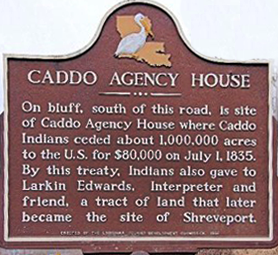 The Caddo can trace their ancestry back to 700AD when the tribes were spread over the areas of Oklahoma, Arkansas, Texas and Louisiana. They had a political hierarchy and were a spiritual, creative and agricultural nation.
The Caddo can trace their ancestry back to 700AD when the tribes were spread over the areas of Oklahoma, Arkansas, Texas and Louisiana. They had a political hierarchy and were a spiritual, creative and agricultural nation.
Back in the 13th century they fought with other tribes in the area, forcing them to relocate further south.
They accepted the intrusion of the European settlers, and as with most native tribes, the diseases imported from Europe killed more of them than bullets and knives.
When France ceded Louisiana to Spain in 1762, many of the native tribes, including the Caddo were extremely upset at the idea of being sold like cattle and caused many problems for the Spanish. However, over the following four decades, their attitudes changed and they became allies.
Soon after the Louisiana purchase had been signed the Caddo were uncertain of the American government and the increasing number 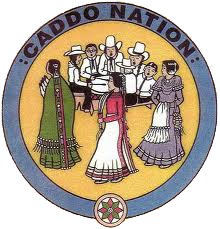 of settlers approaching their territory. Although they received many assurances from the American authorities, by 1836 they had signed a treaty and sold their land to the Americans. They firmly believed that if they delay by another decade it would be taken from them regardless.
of settlers approaching their territory. Although they received many assurances from the American authorities, by 1836 they had signed a treaty and sold their land to the Americans. They firmly believed that if they delay by another decade it would be taken from them regardless.
Their intention to move west into Texas was ruined by the Texan war with Mexico. Over the following years their relationship with the Texans verged on being hostile, but eventually they accepted that the only way that the nation could survive, was to accept the new way of life and to live in peace with the Americans.
As a nation, the Caddo are a federally recognized tribe with its tribal capital based at Binger, Oklahoma.
Natchez
The Natchez were quite an exceptional nation, with tribal leaders called the Great Sun, after their spiritual following of the Sun deity. These chiefs inherited their title through matrilineal decent (female lineage) and could be traced back to the birth of the first Great Sun.
They had an orderly society involving worship of the Sun God and ritual sacrifice. They were an agricultural nation growing maize, corn, beans and other crops and are known for building mounds, which were focal points for worship and communal gatherings.
The De Soto expedition, in 1542 reported them as a great but aggressive nation and fought them with heavy losses.
The French expeditions in the 17th century found them to be both friendly and hostile and struggled to bond with them. These early encounters with Europeans reduced their population with diseases such as cholera and measles, to which they had no immunity.
After further French intrusion, they lived peacefully until 1729 when the nearby French settlement decided that they were going to move to one of the key areas inhabited by the Natchez tribe. This, they said, was not an option and the tribe would have to leave the land which had been inhabited and farmed by them for centuries. After serious consideration they decided to attack the French fort and killed around 200 of the soldiers and their families.
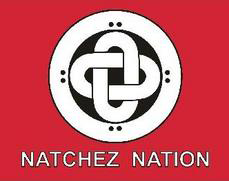 This of course, was met with retaliation and the Natchez, being outnumbered by the French army were mercilessly slaughtered and taken into captivity. The nation had been destroyed, with those who survived being sold into slavery.
This of course, was met with retaliation and the Natchez, being outnumbered by the French army were mercilessly slaughtered and taken into captivity. The nation had been destroyed, with those who survived being sold into slavery.
At one time this great nation might have numbered up to 6,000 living along the Mississippi valley, but now the descendants are diluted by other tribes, as they are not recognized by the federal government and without a reservation of their own.
The Grand Village of the Natchez, offers an insight of how a village might have looked and functioned. This partially reconstructed site and museum can be found near Natchez, Mississippi.
Houma
The Houma (pronounced hoo-mah) were originally part of the Chakchiuma tribe based around the east-central area of Mississippi.
During the second half of the 17th century they settled just north of Louisiana inside the state of Mississippi.
At the turn of the 18th century they suffered a decimating dysentery epidemic, losing almost half of the population. Then in 1708 they were attacked by the Tunica and suffered further loss.
A similar fate had befallen their neighboring tribes, the Acolapissa and Bayougoula; encouraged by the French, they joined the Houma.
Less than sixty years before, the population of these three tribes would have been in excess of ten thousand, but when hit by a devastating outbreak of smallpox in 172 they numbered less than 1,000.
In 1722 a band of around 500 survivors relocated to Ascention Parish, where they remained for a further four years before finally settling in Assumption Parish.
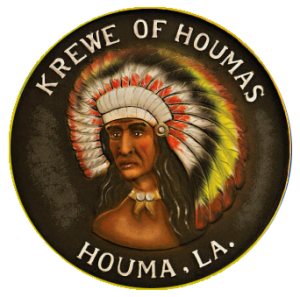 By the 1820's they had moved back south to an area southwest of New Orleans, where many of their decedents still remain.
By the 1820's they had moved back south to an area southwest of New Orleans, where many of their decedents still remain.
In order to survive the Indian wars, the remnants of other tribes, moved south and joined with the Houma nation, after this, mixed marriages and relationships with French and African decedents further diluted any remaining pure blood.
At the start of the 20th century there were less than 1,000 remaining.
Today, most Houma are a Cajun-Creole mix, with a growing interest in their heritage.
The Houma are not officially recognized by the US government and do not have claim to a reservation but they are currently the largest native tribe in the state.
Atakapa
The Atakapa originate from the South-western area of Louisiana and south-east Texas. Although not as numerous as some of the larger Indian nations their decedents have survived and still teach and practice their ancestors traditions.
They were not regarded as farmers, but existed on a diet of nuts, fruit, berries and other edible crops growing wild, combined with the abundant supply of meat and fish from the surrounding bayous and shallow coastal waters.
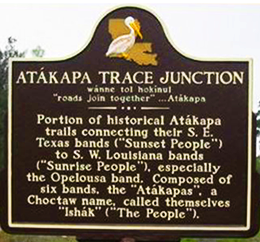 They fought with many of their neighboring tribes, such as the Natchez, Caddo and Houma but also enjoyed periods of peace with many mixed marriages.
They fought with many of their neighboring tribes, such as the Natchez, Caddo and Houma but also enjoyed periods of peace with many mixed marriages.
The called themselves Ishak, meaning the Sunrise or Sunset People. The name of Atakapa is a Choctaw word which means man-eaters or cannibals.
There are no reliable, first-hand reports of this practice, the speculation is something of an urban legend, moving from tribe to tribe, possibly originating from their taking Spanish prisoners and cooking them alive, but not eating them. When the Spanish claimed Mexico and Texas territories, the Atakapa were slaughtered mercilessly and further decimated by European diseases, against which, they had no immunity.
They are not a federally recognized nation, and as such, do not have a reservation. But the strong and growing community is currently lobbying for this.
Choctaw
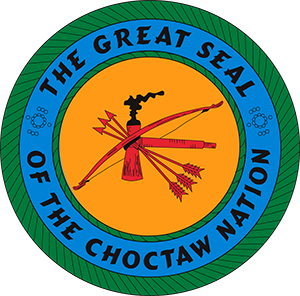 The Choctaw (aka) Chahta, Chactas, Tchakta, Chocktaw, and Chactaw) have a culture dating back nearly 2,000 years and traditionally inhabited an are east of the Mississippi including Louisiana, Mississippi, Alabama and Florida.
The Choctaw (aka) Chahta, Chactas, Tchakta, Chocktaw, and Chactaw) have a culture dating back nearly 2,000 years and traditionally inhabited an are east of the Mississippi including Louisiana, Mississippi, Alabama and Florida.
They suffered years of persecution with the arrival of white settlers and expecting fair treatment and to live peaceful lives, signed many treaties with not only the US Government but also, France, Spain and Britain. as each country fought for the control of American soil.
Being spread over such a wide area, they split into three main tribes which resulted in them fighting for both the English and the Patriots during the civil war
After the Treaty of San Lorenzo in 1795 between the United States and Spain, around 15,000 were moved from their land in Mississippi to Indian Territory, which is now Oklahoma. Less than 13,500 survived the journey, known as the Trail of Tears.
In 1811 the Shawnee chief Tecumseh, tried to persuade nearby tribes to fight against the Americans, but the Choctaw leader, Pushmataha was against this and sided with the Americans. Some Choctaw were among Andrew Jackson's troops fighting against the British at the Battle of New Orleans.
Pushmataha went on to develop a close alliance with the American authorities over the following decade and was visited by Andrew 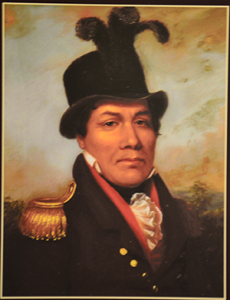 Jackson as he lay dying of a respiratory infection.
Jackson as he lay dying of a respiratory infection.
He died aged sixty, on December 24th 1824 and was buried with full military honors at the Congressional Cemetery in Washington. He is one of only two Native American chiefs to be interred there.
During the First World War, they initiated 'code talking' and were used to transmit messages between army units, where the chance of being eavesdropped was great. Their language completely fooled the enemy.
Jim Crow laws and segregation brought further problems as they were technically labeled as colored, yet on occasion could pass as white.
Today the Choctaw Nation are a federally recognized and run many successful businesses, proudly retaining their history and culture.
Chitimacha
The Chitimacha are a federally recognized tribe and certainly one of the longest established tribes in southern Louisiana. They were possibly established long before any of their neighboring tribes and were a complexly structured nation with integrated clans, formal address and a class system based matrilineal decent.
They existed on natural resources showing respect for their habitat, fishing, hunting and growing maize and other crops.
The French explorer, Jean-Baptiste Le Moyne,Sieur de Iberville encountered the Chitimacha in 1699 and in defense of their land and freedom from slavery, hostilities between the two factions resulted in a war which lasted until 1718, when a peace treaty was signed. The Chitimacha lost suffered more under the French than any other tribes, with a great number of their population forced into slavery.
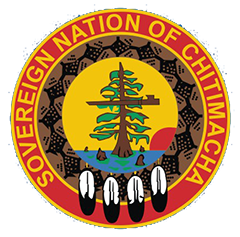 As with other indigenous people, their numbers were reduced dramatically by war and disease.
As with other indigenous people, their numbers were reduced dramatically by war and disease.
They existed peacefully with the Spanish and subsequent American purchase of Louisiana, but still witnessed the reduction of their land as they were eventually squeezed into a reservation.
The tribe have since turned around their fortunes over the last few decades with enviable social and business projects including the Cypress Bayou Casino and Hotel, Raintree Market.
The symbols represented in the Chitimacha logo are as follows: The central component is a cypress tree which represents the Sacred Cypress Tree of the Chitimacha. The sun rising in the east is symbolic of the dawn of a new day. The pipe shown in the center represents peace. The four eagle feathers represent the four directions. Surrounding the center is the bears’ ear/earring basket design. The colors used are of importance to the Chitimacha people, especially the red, black and yellow which were used in basketry and clothing. The logo is used as the central component of the tribal flag; it is surrounded by a field of blue.
